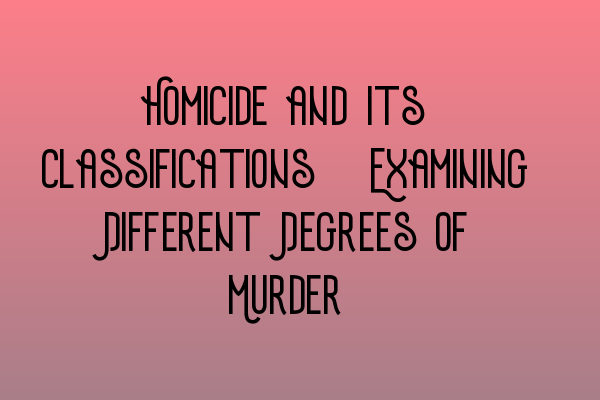Homicide and Its Classifications: Examining Different Degrees of Murder
As solicitors at SQE Criminal Law & Practice Law UK, we believe it’s vital to have a thorough understanding of the different classifications of homicide in order to effectively represent our clients. In this blog post, we will explore the various degrees of murder and provide insights into their legal implications.
First-Degree Murder
First-degree murder is the most severe classification of homicide, involving intentional and premeditated killings. It refers to cases where the offender planned the act with the specific intent to cause the victim’s death. This degree of murder often carries the highest penalties under the law.
Many actions can be considered first-degree murder, such as a deliberate act of poisoning, hiring a hitman, or planning a murder for financial gain. It is essential for criminal law practitioners to gather strong evidence and establish intent beyond a reasonable doubt in first-degree murder cases.
For more information on the SQE 1 Practice Exam Questions, click here.
Second-Degree Murder
Second-degree murder involves intentional killings without premeditation. This classification encompasses acts where the offender had the intent to cause serious harm or was aware that their actions could result in death, but without the specific planning associated with first-degree murder.
Examples of second-degree murder include spontaneous fights resulting in death or acts of extreme recklessness that lead to fatal outcomes. The punishment for second-degree murder is typically less severe than that of first-degree murder, but still carries significant penalties.
If you are preparing for your SQE 1 exams, we highly recommend practicing with SQE 1 Practice Mocks FLK1 FLK2. Visit here for more information.
Voluntary Manslaughter
Voluntary manslaughter occurs when an individual causes the death of another person while under the influence of strong provocation or extreme emotional distress. It involves a diminished intent compared to first and second-degree murder.
Examples of situations that may lead to voluntary manslaughter charges include crimes of passion where an individual reacts spontaneously to a perceived threat or finding a spouse engaging in adultery. Sentencing for voluntary manslaughter is often less severe than for second-degree murder.
Involuntary Manslaughter
Involuntary manslaughter differs from voluntary manslaughter in that it does not involve intent to cause harm or death. It refers to cases where an individual unintentionally causes the death of another person through gross negligence, reckless behavior, or criminal negligence.
Examples of involuntary manslaughter include drunk driving accidents resulting in fatalities, failure to adhere to safety regulations leading to fatal accidents on construction sites, or medical malpractice resulting in patient deaths. The punishment for involuntary manslaughter varies depending on the circumstances surrounding the case.
For SQE 2 preparation courses to further enhance your knowledge, visit here.
Conclusion
Understanding the different classifications of homicide is crucial for criminal law practitioners. By distinguishing between first-degree murder, second-degree murder, voluntary manslaughter, and involuntary manslaughter, legal experts can effectively analyze cases, build robust defense strategies, or advocate for justice on behalf of victims’ families.
For comprehensive SQE 1 preparation courses, click here. Stay up to date with the latest SRA SQE exam dates by visiting here.
